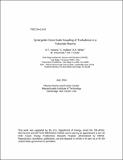| dc.contributor.author | Howard, Nathaniel Thomas | |
| dc.contributor.author | Holland, C. | |
| dc.contributor.author | Candy, J. | |
| dc.contributor.author | Greenwald, Martin J. | |
| dc.contributor.author | White, Anne E. | |
| dc.date.accessioned | 2015-03-05T20:47:32Z | |
| dc.date.available | 2015-03-05T20:47:32Z | |
| dc.date.issued | 2014-11 | |
| dc.date.submitted | 2014-07 | |
| dc.identifier.issn | 1070-664X | |
| dc.identifier.issn | 1089-7674 | |
| dc.identifier.uri | http://hdl.handle.net/1721.1/95897 | |
| dc.description.abstract | For the first time, nonlinear gyrokinetic simulations spanning both the ion and electron spatio-temporal scales have been performed with realistic electron mass ratio ((m[subscript D] [over m [subscript e])[superscript 1 over 2] = 60.0), realistic geometry, and all experimental inputs, demonstrating the coexistence and synergy of ion (k[subscript θρs] ~O(1.0)) and electron-scale (k[subscript θρe] ~O(1.0)) turbulence in the core of a tokamak plasma. All multi-scale simulations utilized the GYRO code [J. Candy and R. E. Waltz, J. Comput. Phys. 186, 545 (2003)] to study the coupling of ion and electron-scale turbulence in the core (r/a = 0.6) of an Alcator C-Mod L-mode discharge shown previously to exhibit an under-prediction of the electron heat flux when using simulations only including ion-scale turbulence. Electron-scale turbulence is found to play a dominant role in setting the electron heat flux level and radially elongated (k[subscript r] ≪ k[subscript θ]) “streamers” are found to coexist with ion-scale eddies in experimental plasma conditions. Inclusion of electron-scale turbulence in these simulations is found to increase both ion and electron heat flux levels by enhancing the transport at the ion-scale while also driving electron heat flux at sub-ρ[subscript i] scales. The combined increases in the low and high-k driven electron heat flux may explain previously observed discrepancies between simulated and experimental electron heat fluxes and indicates a complex interaction of short and long wavelength turbulence. | en_US |
| dc.description.sponsorship | United States. Dept. of Energy. Office of Science (Contract DE-AC02-05CH11231) | en_US |
| dc.description.sponsorship | United States. Dept. of Energy (Contract DE-FC02-99ER54512-CMOD) | en_US |
| dc.description.sponsorship | United States. Dept. of Energy. Fusion Energy Postdoctoral Research Program (Oak Ridge Institute for Science and Education) | en_US |
| dc.language.iso | en_US | |
| dc.publisher | American Institute of Physics (AIP) | en_US |
| dc.relation.isversionof | http://dx.doi.org/10.1063/1.4902366 | en_US |
| dc.rights | Creative Commons Attribution-Noncommercial-Share Alike | en_US |
| dc.rights.uri | http://creativecommons.org/licenses/by-nc-sa/4.0/ | en_US |
| dc.source | MIT web domain | en_US |
| dc.title | Synergistic cross-scale coupling of turbulence in a tokamak plasma | en_US |
| dc.type | Article | en_US |
| dc.identifier.citation | Howard, N. T., C. Holland, A. E. White, M. Greenwald, and J. Candy. “Synergistic Cross-Scale Coupling of Turbulence in a Tokamak Plasma.” Phys. Plasmas 21, no. 11 (November 2014): 112510. | en_US |
| dc.contributor.department | Massachusetts Institute of Technology. Department of Nuclear Science and Engineering | en_US |
| dc.contributor.department | Massachusetts Institute of Technology. Plasma Science and Fusion Center | en_US |
| dc.contributor.mitauthor | Greenwald, Martin J. | en_US |
| dc.contributor.mitauthor | White, Anne E. | en_US |
| dc.relation.journal | Physics of Plasmas | en_US |
| dc.eprint.version | Original manuscript | en_US |
| dc.type.uri | http://purl.org/eprint/type/JournalArticle | en_US |
| eprint.status | http://purl.org/eprint/status/NonPeerReviewed | en_US |
| dspace.orderedauthors | Howard, N. T.; Holland, C.; White, A. E.; Greenwald, M.; Candy, J. | en_US |
| dc.identifier.orcid | https://orcid.org/0000-0003-2951-9749 | |
| dc.identifier.orcid | https://orcid.org/0000-0002-4438-729X | |
| mit.license | OPEN_ACCESS_POLICY | en_US |
| mit.metadata.status | Complete | |
